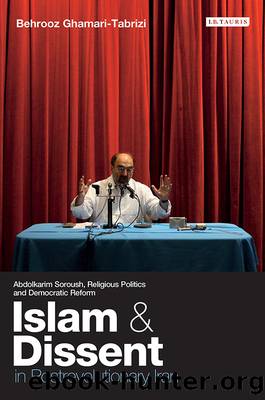Islam and Dissent in Postrevolutionary Iran by Behrooz Ghamari-Tabrizi

Author:Behrooz Ghamari-Tabrizi [Ghamari-Tabrizi, Behrooz]
Language: eng
Format: epub
Tags: Religion, Religion; Politics & State, Political Science, General
ISBN: 9781786734921
Google: Db-qDwAAQBAJ
Publisher: Bloomsbury Publishing
Published: 2008-04-08T22:28:24+00:00
6
From Liberation Theology to State Ideology: Ali Shari`ati and the Emergence of New Religious Intellectuals
On May 23, 1997, Mohammad Khatami, the Director of the National Library, won a landslide victory in the presidential election against Nateq Nuri, the Speaker of the majlis and the Supreme Leaderâs favored candidate to replace Rafsanjani. Khatamiâs victory highlighted two major transformations in the postrevolutionary regime. First, by choosing the candidate of the opposition, the electorate, urban as well as rural, demonstrated that the nation had moved from a revolutionary mass society towards a civil society. Gone were the days when the Supreme Leader could carry out his wishes and legitimize them by mobilizing millions of people. Now institutional and structural means offered possibilities to a loyal opposition to muster popular support for their own political projects. Second, and perhaps politically more important, for the first time in the short history of the republic, the Supreme Leader sanctioned the results of an election that had brought into office a president whom he did not endorse.
It is now common wisdom that the growing numbers of educated youth and professional women played an instrumental role in electing Khatami. Along with structural and institutional changes in society, such as demographic changes in urban population growth, the high ratio of youth population, and massive increase in literacy, the dominant discursive shift from the old revolutionary modus vivendi to a more pragmatic opus practicum under Rafsanjaniâs administration paved the way for Khatamiâs platform of political reform. During the first term of Rafsanjaniâs presidency, while Khatami presided over the Ministry of Culture and Islamic Guidance (1988-1992) the number of daily newspapers and weekly journals grew from 102 to 369.
Rafsanjani, the champion of perestroika, realized that a movement for glasnost was in the making by an emerging class of public intellectuals and independent media. Rafsanjaniâs critics in Qom and the conservative clerical establishment, led by Ayatollah Jannati and his foot soldiers at the SetÄd-e IhyÄ-ye Amr-e be MÃ ruf va Nah-ye az Monkar (The Headquarters for the Restoration of the Propagation of Virtue and Prohibition of Vice), feared the emerging public intellectuals for their rejection of the clerical monopoly of the interpretation of Islam. Rafsanjani dreaded their demands for transparency in governance. Under his presidency, the percentage of people living below the poverty line dropped from more than 27 per cent to less than 19 per cent, but that decrease occurred with a concomitant rise in the disparity between rich and poor.1 Recall that Rafsanjani had extolled the virtues of prosperity, disdained revolutionary asceticism, and embraced the laissez faire Islamism of the nouveau riche. However, neither he nor Khatami after him abandoned altogether the extensive state-sponsored economic planning, which generally benefited the poor.
As Djavad Salehi-Isfahani has shown, in comparison to countries with similar economic and social resources, the Islamic Republic has the lowest percentage of population living in absolute poverty. Yet it shares the same rank with other nations in its distributive inequality (see the Gini index).2 While successive administrations implemented various versions
Download
This site does not store any files on its server. We only index and link to content provided by other sites. Please contact the content providers to delete copyright contents if any and email us, we'll remove relevant links or contents immediately.
| Bahrain | Egypt |
| Iran | Iraq |
| Israel & Palestine | Jordan |
| Kuwait | Lebanon |
| Oman | Qatar |
| Saudi Arabia | Syria |
| Turkey | United Arab Emirates |
| Yemen |
Empire of the Sikhs by Patwant Singh(22977)
The Wind in My Hair by Masih Alinejad(5034)
Rise and Kill First by Ronen Bergman(4705)
The Templars by Dan Jones(4629)
The Rape of Nanking by Iris Chang(4139)
12 Strong by Doug Stanton(3509)
Blood and Sand by Alex Von Tunzelmann(3140)
Babylon's Ark by Lawrence Anthony(2622)
The History of Jihad: From Muhammad to ISIS by Spencer Robert(2573)
No Room for Small Dreams by Shimon Peres(2320)
The Turkish Psychedelic Explosion by Daniel Spicer(2314)
Gideon's Spies: The Secret History of the Mossad by Gordon Thomas(2305)
Inside the Middle East by Avi Melamed(2305)
Arabs by Eugene Rogan(2263)
The First Muslim The Story of Muhammad by Lesley Hazleton(2219)
Come, Tell Me How You Live by Mallowan Agatha Christie(2212)
Bus on Jaffa Road by Mike Kelly(2104)
Kabul 1841-42: Battle Story by Edmund Yorke(1986)
1453 by Roger Crowley(1969)
